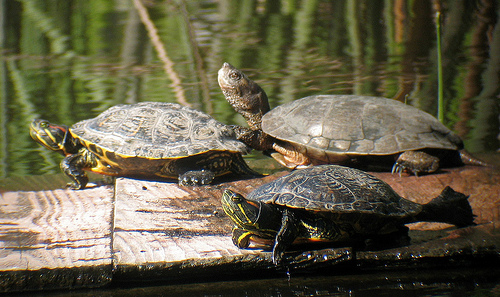
|
|
Western Pond Turtle - Actinemys marmorataOverviewThe Western Pond Turtle is the only native freshwater turtle on the Pacific Coast. The length ranges from 3.5 to 8.5 inches (9 to 21.5 cm) and can be seen as dark brown, black, or dark green. The top of the shell, or the carapace, is covered in lighter colored spots that radiate outwards. The underside of the shell, or the plastron, is a lightish yellow color. The Western Pond Turtle is diurnal. Its predators consist of raccoons, coyotes, skunks, and foxes. They are particularly vulnerable when emerging from eggs and are sought after by ravens, garter snakes, bass, egrets, and herons. The hibernation period is from December until January where they will bury themselves in mud or cover themselves in leaf litter or poison oak. They can be found basking in the warm sunlight on raised rocks or logs extending out of ponds in the other months of the year. When defending a basking spot, the Western Pond Turtle may open its mouth, bite, or ram. When danger is sensed, they will dive into the water. During droughts, the Western Pond Turtle will cover itself in the mud found at the bottom of the pond. Mating begins in April and May. Nests will be dug on land about 90 to 130 feet from the water in which 2 to 11 eggs will be laid. Young will emerge from eggs in about 12 weeks. Its diet consists of algae, cattail roots, larvae, frog eggs, small fish, carrion, worms, and other invertebrates, but mostly insects. The Western Pond Turtle was recently split into 2 species - Northern Western Pond Turtle and Southern Western Pond Turtle. The Bay area is sort of at the dividing line between the two species. Scientists are still sorting it out, so we will continue to use Western Pond Turtle for now.  Comparison of Western Pond Turtle and Red-eared Slider (non-native) Photo credit Ken Schneider/Flickr Status and ConservationThe Western Pond Turtle is listed as a Federal Special Concern Species and a California Special Concern Species. This status has not been updated since 1996. Populations are widely spread in Northern California, but numbers are declining, and populations are almost extinct in some areas. In the 19th and 20th century, Western Pond Turtles were hunted for food in the Bay Area. One cause for the decline is competition from non-native turtles. Many Red-Eared Sliders (Trachemys scripta) have come to inhabit the same areas as the Western Pond Turtles, such as at Stow Lake in the Golden Gate Park and Phoenix and Alpine lakes in Marin County. Families who no longer can take care of their pet Sliders release them into the wild, which causes problems for the natural ecosystem. These Sliders are larger and more aggressive than the Western Pond Turtles. They also brought new diseases and lay more eggs. Besides nonnative competitors and human consumption, habitat loss and destruction due to development has caused population numbers to decline. Because females build nests far from their water source, females, eggs, and newborns are particularly vulnerable to predation, being trampled by humans or cattle, and being run over by vehicles. Because of the high mortality rate in females, the turtle sex ratio is 4 males to 1 female. The building of dams may also be a cause of the drop in population numbers for the Western Pond Turtle. Dams lower the water temperature in which the turtles inhabit. The cooler waters may favor adult turtles, but hinder the growth and survival rates of young turtles. Much is being done in the Bay Area to counter declining numbers of Western Pond Turtles. In many development plans, the Western Pond Turtle is mentioned as a species of concern. In some cases, such as the Valero Refining Company in Benicia, the Western Pond Turtles on the construction site were relocated. Due to the fact that young Western Pond Turtles only have an 8-12% survival rate, the Oakland Zoo, the San Francisco Zoo, and Sonoma State University have teamed up to create a conservation plan for these turtles. Because turtle gender is determined by the temperature of the egg, the project incubates eggs in specific environments to create an even number of female to male offspring. Once the young turtles are of a size that gives them a greater chance of survival, they are released back into the wild. More about this can be read here and here. Other conservation efforts include protecting nesting areas within enclosures and enhancing habitats through the addition of basking sites. Where to View
Articles and Links
|
